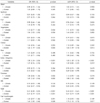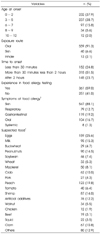1. Sicherer SH, Sampson HA. Food allergy. J Allergy Clin Immunol. 2010; 125:2 Suppl 2. S116–S125.

2. Illi S, von Mutius E, Lau S, Nickel R, Grüber C, Niggemann B, et al. The natural course of atopic dermatitis from birth to age 7 years and the association with asthma. J Allergy Clin Immunol. 2004; 113(5):925–931.

3. Spergel JM. From atopic dermatitis to asthma: the atopic march. Ann Allergy Asthma Immunol. 2010; 105(2):99–106.

4. Bantz SK, Zhu Z, Zheng T. The atopic march: progression from atopic dermatitis to allergic rhinitis and asthma. J Clin Cell Immunol. 2014; 5(2):202.

5. Grundy J, Matthews S, Bateman B, Dean T, Arshad SH. Rising prevalence of allergy to peanut in children: data from 2 sequential cohorts. J Allergy Clin Immunol. 2002; 110(5):784–789.

6. Kim YH, Lee SY, Lee E, Cho HJ, Kim HB, Kwon JW, et al. The change in food allergy prevalence of elementary school children in Seoul since the last 20 years and the risk factor analysis. Allergy Asthma Respir Dis. 2016; 4(4):276–283.

7. Lack G. Epidemiologic risks for food allergy. J Allergy Clin Immunol. 2008; 121(6):1331–1336.

8. Love BL, Mann JR, Hardin JW, Lu ZK, Cox C, Amrol DJ. Antibiotic prescription and food allergy in young children. Allergy Asthma Clin Immunol. 2016; 12(1):41.

9. Sicherer SH. Epidemiology of food allergy. J Allergy Clin Immunol. 2011; 127(3):594–602.

10. Min TK, Pyun BY, Kim HH, Park YM, Jang GC, Kim HY, et al. Epidemiology of food allergy in Korean children. Allergy Asthma Respir Dis. 2018; 6(1):4–13.

11. Seo AD, Lee JY, Yang SI, Lee HR, Lee SY. Food allergic reactions in the community: a questionnaire survey of caregivers. Allergy Asthma Respir Dis. 2017; 5(1):27–33.

12. Hwang JY, Kim MJ, Lee JY, Yang HK, Lee KJ, Jeon HY, et al. Perception of food allergy among parents and school health instructors: a nationwide survey in 2015. Allergy Asthma Respir Dis. 2018; 6(2):97–102.

13. Son DK, Hong SY, Kim HJ, Yum HY, Lee SH, Cho MR, et al. Effectiveness of the atopy camp for primary school students in Seoul. Pediatr Allergy Respir Dis. 2012; 22(2):154–162.

14. Kwon JW, Seo JH, Yu J, Kim BJ, Kim HB, Lee SY, et al. Relationship between the prevalence of allergic rhinitis and allergen sensitization in children of Songpa area, Seoul. Pediatr Allergy Respir Dis. 2011; 21(1):47–55.

15. Hong SJ, Ahn KM, Lee SY, Kim KE. The prevalences of asthma and allergic diseases in Korean children. Korean J Pediatr. 2008; 51(4):343–350.

16. Williams H, Robertson C, Stewart A, Aït-Khaled N, Anabwani G, Anderson R, et al. Worldwide variations in the prevalence of symptoms of atopic eczema in the International Study of Asthma and Allergies in Childhood. J Allergy Clin Immunol. 1999; 103(1 Pt 1):125–138.

17. Ahn K. The past, present, and future of the research on food allergy in Korean children. Allergy Asthma Respir Dis. 2018; 6:Suppl 1. S44–S51.

18. Ellwood P, Asher MI, Björkstén B, Burr M, Pearce N, Robertson CF, et al. ISAAC Phase One Study Group. Diet and asthma, allergic rhinoconjunctivitis and atopic eczema symptom prevalence: an ecological analysis of the International Study of Asthma and Allergies in Childhood (ISAAC) data. Eur Respir J. 2001; 17(3):436–443.

19. Seo WH, Jang EY, Han YS, Ahn KM, Jung JT. Management of food allergies in young children at a child care center and hospital in Korean. Pediatr Allergy Respir Dis. 2011; 21(1):32–38.

20. Dharmage SC, Lowe AJ, Matheson MC, Burgess JA, Allen KJ, Abramson MJ. Atopic dermatitis and the atopic march revisited. Allergy. 2014; 69(1):17–27.

21. Keet CA, Savage JH, Seopaul S, Peng RD, Wood RA, Matsui EC. Temporal trends and racial/ethnic disparity in self-reported pediatric food allergy in the United States. Ann Allergy Asthma Immunol. 2014; 112(3):222–229.

22. Gupta RS, Springston EE, Warrier MR, Smith B, Kumar R, Pongracic J, et al. The prevalence, severity, and distribution of childhood food allergy in the United States. Pediatrics. 2011; 128(1):e9–e17.

23. Smith PK, Masilamani M, Li XM, Sampson HA. The false alarm hypothesis: Food allergy is associated with high dietary advanced glycation end-products and proglycating dietary sugars that mimic alarmins. J Allergy Clin Immunol. 2017; 139(2):429–437.

24. Seoul Medical Center. Relationship between prevalence of atopic diseases and living environment. Seoul: Seoul Medical Center;2016.
25. Jung YH, Ko H, Kim HY, Seo JH, Kwon JW, Kim BJ, et al. Prevalence and risk factors of food allergy in preschool children in Seoul. Korean J Asthma Allergy Clin Immunol. 2011; 31(3):177–183.
26. Kim YG, Yu KH, Ly SY. Perception of elementary school parents in Gyeongbuk area on allergenic food labeling system and children's food allergy status. Korean J Hum Ecol. 2013; 22(5):491–506.

27. Cho W, Kim J. The current state of food allergy of preschool child care facilities in Hanam. Korean J Community Nutr. 2015; 20(4):251–258.
28. Kim SB, Kim JH. Food allergy awareness and nutritional management by preschooler's faculty members of child care facilities. Korean J Community Nutr. 2017; 22(4):298–306.

29. Park JY, Park GY, Han YS, Shin MY. Survey of food allergy in elementary school children in Bucheon-city and relationship between food allergy and other allergic diseases. Allergy Asthma Respir Dis. 2013; 1(3):266–273.

30. Lee AH, Kim KE, Lee KE, Kim SH, Wang TW, Kim KW, et al. Prevalence of food allergy and perceptions on food allergen labeling in school foodservice among Korean students. Allergy Asthma Respir Dis. 2013; 1(3):227–234.

31. Kim M, Lee JY, Jeon HY, Yang HK, Lee KJ, Han Y, et al. Prevalence of immediate-type food allergy in Korean schoolchildren in 2015: a nationwide, population-based study. Allergy Asthma Immunol Res. 2017; 9(5):410–416.

32. Jeong K, Kim J, Ahn K, Lee SY, Min TK, Pyun BY, et al. Age-based causes and clinical characteristics of immediate-type food allergy in Korean children. Allergy Asthma Immunol Res. 2017; 9(5):423–430.

33. McGowan EC, Keet CA. Prevalence of self-reported food allergy in the National Health and Nutrition Examination Survey (NHANES) 2007-2010. J Allergy Clin Immunol. 2013; 132(5):1216–1219.e5.

34. Kotz D, Simpson CR, Sheikh A. Incidence, prevalence, and trends of general practitioner-recorded diagnosis of peanut allergy in England, 2001 to 2005. J Allergy Clin Immunol. 2011; 127(3):623–630.e1.

35. Wu TC, Tsai TC, Huang CF, Chang FY, Lin CC, Huang IF, et al. Prevalence of food allergy in Taiwan: a questionnaire-based survey. Intern Med J. 2012; 42(12):1310–1315.

36. Jeon YH, Kim H, Park YM, Jang GC, Kim HY, Yum HY, et al. The current status and issue of food allergen labeling in Korea. Allergy Asthma Respir Dis. 2019; 7(2):67–72.

37. Liu X, Wong CC, Yu IT, Zhang Z, Tan L, Lau AP, et al. Dietary patterns and the risk of rhinitis in primary school children: a prospective cohort study. Sci Rep. 2017; 7:44610.

38. Yoon SH, Kim HM, Ye YM, Kang YM, Suh CH, Nahm DH, et al. IgE sensitization to the potato allergen in adult allergy patients and identification of IgE binding components: comparison between the wild and genetically modified potato. Korean J Med. 2005; 69(6):651–659.
39. Park HJ, Sung JM, Kim MJ, Choi GS, Shin YS, Ye YM, et al. Allergic contact urticaria caused by raw potato: report of a case. Korean J Asthma Allergy Clin Immunol. 2008; 28(2):148–151.
40. Lee S, Lee H, Han Y, Ahn K, Lee S, Chung SJ. Excessive food restriction in children with atopic dermatitis. Korean J Community Nutr. 2011; 16(6):627–635.
41. Sampson HA. Food allergy. Part 1: immunopathogenesis and clinical disorders. J Allergy Clin Immunol. 1999; 103(5 Pt 1):717–728.

42. Savage JH, Matsui EC, Skripak JM, Wood RA. The natural history of egg allergy. J Allergy Clin Immunol. 2007; 120(6):1413–1417.

43. Lee SY. Factors related with the natural course of food allergy. Allergy Asthma Respir Dis. 2017; 5(5):237–238.

44. Mitre E, Susi A, Kropp LE, Schwartz DJ, Gorman GH, Nylund CM. Association between use of acid-suppressive medications and antibiotics during infancy and allergic diseases in early childhood. JAMA Pediatr. 2018; 172(6):e180315.

45. Kim MH, Suh DI, Lee SY, Kim YK, Cho YJ, Cho SH. Microbiome research in food allergy and atopic dermatitis. Allergy Asthma Respir Dis. 2016; 4(6):389–398.

46. Kinross JM, Darzi AW, Nicholson JK. Gut microbiome-host interactions in health and disease. Genome Med. 2011; 3(3):14.

47. Wang J, Visness CM, Sampson HA. Food allergen sensitization in inner-city children with asthma. J Allergy Clin Immunol. 2005; 115(5):1076–1080.

48. Zheng T, Yu J, Oh MH, Zhu Z. The atopic march: progression from atopic dermatitis to allergic rhinitis and asthma. Allergy Asthma Immunol Res. 2011; 3(2):67–73.







 PDF
PDF ePub
ePub Citation
Citation Print
Print





 XML Download
XML Download